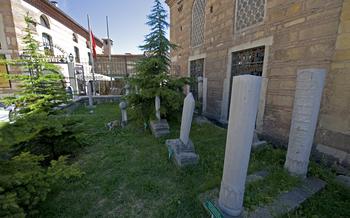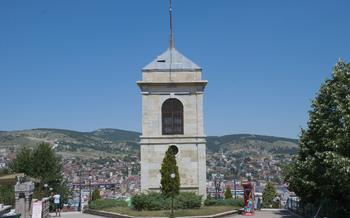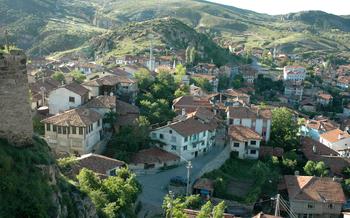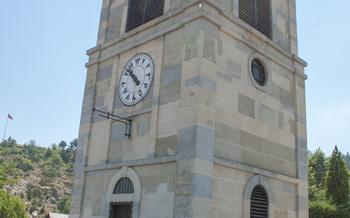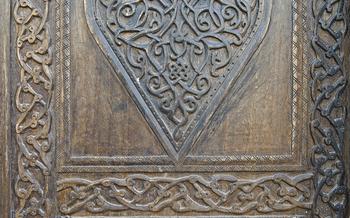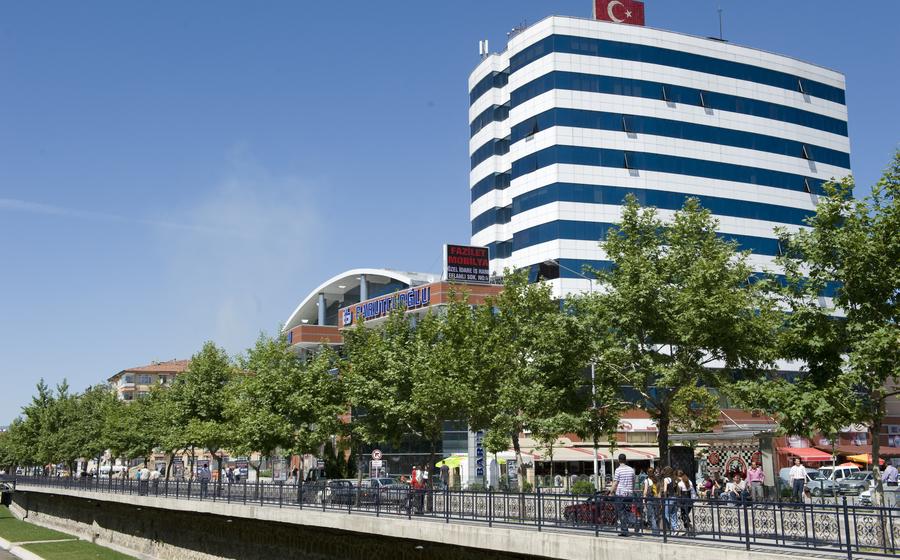
Kastamonu Tobacco and Nicotiana Museum
- Kastamonu Tobacco and Nicotiana Museum: A Journey into the World of Tobacco
- Location and Accessibility
- Architectural Charm
- Interactive Exhibits
- Historical Artifacts
- Economic Importance:
- Local Craftsmanship: A Legacy of Skill and Tradition
- Educational Programs
- Temporary Exhibitions: A Dynamic Showcase of Tobacco History and Culture
- Souvenir Shop
- Insider Tip: Embracing the Authentic Experience
Kastamonu Tobacco and Nicotiana Museum: A Journey into the World of Tobacco
In the heart of Kastamonu, a city steeped in history and tradition, lies a unique treasure that invites visitors on a captivating journey into the world of tobacco. The Kastamonu Tobacco and Nicotiana Museum stands as a testament to the rich cultural heritage of tobacco cultivation and use in Turkey, showcasing an extraordinary collection of artifacts, interactive exhibits, and historical insights.
Tobacco holds a significant place in Turkey's history, dating back to the 16th century when it was introduced by Ottoman traders. Since then, tobacco cultivation has become an integral part of the country's agricultural landscape and a source of livelihood for many communities. The establishment of the Kastamonu Tobacco and Nicotiana Museum in 2013 marked a pivotal moment in preserving and showcasing this rich legacy for future generations.
The museum's collection is a treasure trove of historical artifacts, tools, and documents that provide a comprehensive overview of tobacco cultivation, processing, and its deep-rooted connection to Turkish culture. Visitors can embark on a journey through time, tracing the evolution of tobacco use from its humble beginnings to its widespread popularity as a cash crop and a symbol of social interaction.
Location and Accessibility
The Kastamonu Tobacco and Nicotiana Museum is conveniently located in the heart of Kastamonu city, at Atatürk Bulvarı No:42, Merkez. Visitors can easily reach the museum on foot from the city center or by taking public transportation. Several bus lines stop nearby, including the 1, 2, and 3 lines, which depart from various points in the city. For those traveling by car, there is ample street parking available in the vicinity of the museum.
Additionally, the museum is situated in close proximity to several other popular attractions in Kastamonu, making it an ideal stop on a comprehensive sightseeing tour of the city. The Kastamonu Castle, with its impressive fortifications and panoramic views, is just a short walk away. Visitors can also explore the Ethnography Museum, which offers a glimpse into the rich cultural traditions of the region, or stroll through the vibrant bazaars, where they can find a variety of local handicrafts and souvenirs.
Architectural Charm
The Kastamonu Tobacco and Nicotiana Museum stands out not only for its collection but also for its architectural charm. Housed in a beautifully renovated 19th-century building, the museum showcases a blend of traditional and modern elements. The exterior facade features elegant stonework and intricate carvings, reflecting the region's rich history and craftsmanship. Inside, visitors are greeted by a spacious and well-lit interior, adorned with high ceilings, polished wooden floors, and large windows that allow natural light to flood in.
The museum's design seamlessly integrates modern amenities with the building's original character. Interactive displays and exhibits are tastefully incorporated into the historic spaces, creating a harmonious blend of old and new. The museum's commitment to preserving and showcasing the region's tobacco heritage is evident in every aspect of its design, making it a delight for visitors to explore and learn.
Interactive Exhibits
The Kastamonu Tobacco and Nicotiana Museum offers a range of interactive exhibits that engage visitors and enhance their understanding of tobacco history. These exhibits are designed to provide a hands-on experience, allowing visitors to explore the world of tobacco in a fun and engaging way.
One of the most popular interactive exhibits is a virtual tour of a tobacco farm. Visitors can don virtual reality headsets and immerse themselves in the sights, sounds, and smells of a traditional tobacco farm. They can explore the fields, learn about the different stages of tobacco cultivation, and interact with virtual farmers.
Another interactive exhibit allows visitors to experience the process of tobacco curing. They can manipulate virtual tobacco leaves, adjusting the temperature and humidity to see how these factors affect the curing process. Visitors can also learn about the different types of curing techniques used in different parts of the world.
In addition to these virtual experiences, the museum also offers a variety of hands-on activities. Visitors can roll their own cigarettes, learn how to pack a pipe, and even try their hand at making traditional tobacco products. These activities provide a unique and memorable way for visitors to connect with the history and culture of tobacco.
Historical Artifacts
The Kastamonu Tobacco and Nicotiana Museum houses a fascinating collection of historical artifacts that narrate the rich story of tobacco cultivation and processing in Turkey. Among these treasures, visitors will find rare and unique items that hold particular significance. One such artifact is an intricately carved wooden pipe dating back to the 18th century. Its ornate design and intricate craftsmanship offer a glimpse into the artistry and skill of tobacco pipe makers from that era.
Another highlight of the collection is a well-preserved tobacco press used in the early 20th century. This remarkable machine demonstrates the traditional methods employed to compress and shape tobacco leaves into various forms. Visitors can also admire a collection of antique tobacco tins and containers, each adorned with vibrant colors and intricate patterns, showcasing the artistic expression associated with tobacco packaging.
Through these historical artifacts, the museum brings to life the stories of the people who cultivated, processed, and enjoyed tobacco throughout history. Each item holds a unique tale, offering visitors a deeper understanding of the cultural and economic significance of tobacco in Turkey.
Economic Importance:
Tobacco cultivation and production have played a significant role in the economy of Kastamonu. The region's fertile soil and favorable climate have made it an ideal place for tobacco farming, which has provided a livelihood for many local families for generations. The sale of tobacco leaves and tobacco products has contributed to the local economy, creating jobs and generating revenue.
One of the most famous tobacco products from Kastamonu is the "Kastamonu cigar", which is renowned for its unique flavor and aroma. The production of these cigars has become a significant industry in the region, with many local farmers and artisans involved in the cultivation, processing, and manufacturing of the cigars.
In recent years, there has been a growing emphasis on promoting sustainable tobacco farming practices in Kastamonu. This includes initiatives aimed at reducing the environmental impact of tobacco production, such as the adoption of organic farming methods and the use of renewable energy sources in the curing process. These efforts ensure the long-term viability of tobacco farming in the region while also preserving the unique cultural heritage associated with it.
Local Craftsmanship: A Legacy of Skill and Tradition
The Kastamonu Tobacco and Nicotiana Museum not only delves into the history and significance of tobacco but also showcases the exquisite craftsmanship associated with tobacco production in the region. Visitors can admire the intricate pembuatan of traditional tobacco pipes, known as "çubuk," which are meticulously handcrafted by skilled artisans. These pipes, often adorned with intricate carvings and designs, are a testament to the artistry and precision of local craftsmen.
In addition to pipes, the museum displays a variety of other tobacco-related items, such as containers, pouches, and accessories. These beautifully crafted objects reflect the deep connection between tobacco and the local culture, as well as the ingenuity and creativity of Kastamonu's artisans. Visitors can marvel at the intricate designs and patterns that adorn these items, each of which tells a story of tradition, skill, and craftsmanship.
The museum's collection of tobacco-related crafts provides a glimpse into the rich cultural heritage of the region and showcases the exceptional skills of local artisans. These items are not only functional but also works of art, embodying the creativity and dedication of the craftsmen who pour their heart and soul into their craft.
Educational Programs
The Kastamonu Tobacco and Nicotiana Museum offers a range of educational programs and workshops to deepen visitors' understanding of tobacco history, cultivation, and its cultural significance. These programs are designed to cater to diverse audiences, including students, researchers, and the general public.
School groups can book guided tours tailored to their curriculum, allowing students to explore the museum's exhibits and engage in hands-on activities related to tobacco. These tours provide an immersive and interactive learning experience that complements classroom lessons.
The museum also hosts workshops and seminars on various tobacco-related topics. Experts in tobacco cultivation, processing, and cultural history share their knowledge and insights, offering participants an opportunity to delve deeper into the world of tobacco. These workshops are open to the public and provide a platform for discussions, Q&A sessions, and networking.
Additionally, the museum collaborates with universities and research institutions to facilitate research projects and internships. Researchers can access the museum's collection and resources to conduct studies on tobacco history, agriculture, and its impact on society. These collaborations contribute to the advancement of knowledge and understanding of tobacco's multifaceted role throughout history.
Temporary Exhibitions: A Dynamic Showcase of Tobacco History and Culture
The Kastamonu Tobacco and Nicotiana Museum not only houses a permanent collection but also hosts a variety of temporary exhibitions and special events throughout the year. These exhibitions delve deeper into specific aspects of tobacco history, culture, and its impact on society. They showcase rare artifacts, artworks, and interactive displays that complement the museum's permanent collection and offer visitors a fresh perspective on the world of tobacco.
Temporary exhibitions may explore themes such as the role of tobacco in art and literature, the evolution of tobacco packaging and advertising, or the history of smoking customs and rituals around the world. They often feature collaborations with renowned experts, artists, and institutions to bring unique and thought-provoking content to the museum's visitors.
By hosting temporary exhibitions, the Kastamonu Tobacco and Nicotiana Museum strives to create a dynamic and engaging experience for its visitors. These exhibitions provide an opportunity to explore new dimensions of tobacco history and culture, while also highlighting the museum's commitment to preserving and promoting this rich heritage.
Keep an eye on the museum's website or social media pages for announcements about upcoming temporary exhibitions. These events offer a chance to delve deeper into the fascinating world of tobacco and gain new insights into its cultural significance.
Souvenir Shop
A visit to the Kastamonu Tobacco and Nicotiana Museum is not complete without a stop at its charming souvenir shop. Here, visitors can find a wide range of unique and locally-made items that reflect the museum's theme and the rich tobacco heritage of Kastamonu. From intricately designed tobacco pipes and decorative ashtrays to artisanal tobacco-themed jewelry and accessories, there's something to suit every taste and budget.
One of the highlights of the souvenir shop is its collection of traditional Turkish tobacco pipes, known as "narghile" or "shisha." These ornate pipes, handcrafted by skilled artisans, come in various sizes and designs, each a testament to the artistry and craftsmanship of the region. Visitors can choose from a range of intricate patterns and vibrant colors, making these pipes not just functional but also beautiful decorative pieces.
The souvenir shop also offers a variety of tobacco-themed merchandise, such as t-shirts, caps, and bags, allowing visitors to take a piece of the museum's experience home with them. These items are not only stylish but also serve as a reminder of the fascinating world of tobacco and its cultural significance in Turkey.
Insider Tip: Embracing the Authentic Experience
To fully immerse yourself in the world of tobacco history and culture, consider visiting the Kastamonu Tobacco and Nicotiana Museum during the annual tobacco harvest festival. Held in late summer, this vibrant event showcases the region's rich tobacco heritage through live demonstrations, traditional music and dance performances, and a bustling marketplace where you can interact with local farmers and purchase freshly harvested tobacco products. It's an exceptional opportunity to witness the passion and dedication that goes into tobacco cultivation and to connect with the local community in a truly authentic way.

